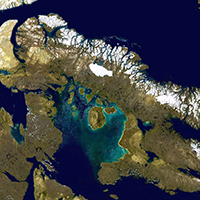Physical and chemical characteristics of 1300 lakes and ponds across the Canadian Arctic
Characteristics of Canadian Arctic lakes and ponds

Accepted: 25 August 2020
Supplementary: 107
HTML: 255
All claims expressed in this article are solely those of the authors and do not necessarily represent those of their affiliated organizations, or those of the publisher, the editors and the reviewers. Any product that may be evaluated in this article or claim that may be made by its manufacturer is not guaranteed or endorsed by the publisher.
Authors
Lakes and ponds are a major feature of the Arctic landscape and are recognized as effective ‘sentinels of change’. Here we present water chemistry characteristics of lakes and ponds (n=1300 with 26 variables) across the Canadian Arctic collated from published studies. We also extracted geological and ecoregion data in an attempt to determine the key drivers. In general, most lakes were shallow (85.4%, <10 m), nutrient (phosphorus) poor (oligotrophic = 45.6% and ultra-oligotrophic = 24.8%), located at low elevation (66.5%, <200 m asl), close to coastlines (72.5%, 0-50 km), and underlain by sedimentary geology (66.5%). The first two components from Principal Component Analysis explained 49.3% of the variation in the dataset; the first component was dominated by conductivity/carbonate materials, and the second component suggested allochthonous inputs of phosphorus. In general, bedrock geology is the primary driver of water chemistry; as such, there were major differences between lakes underlain by igneous and sedimentary rocks. Those on sedimentary bedrock tend to have higher pH, nutrients and higher inorganic ion concentrations.
Edited by
Michela Rogora, CNR-IRSA Verbania, ItalyHow to Cite
Similar Articles
- Emilia Rota, Marco Bartoli, Alex Laini, First time in Italy. Is the elusive aquatic megadrile Sparganophilus Benham, 1892 (Annelida, Clitellata) accelerating its dispersal in Europe? , Journal of Limnology: Vol. 73 No. 3 (2014)
- Stefan Sommer, Roberta Piscia, Marina M. Manca, Diego Fontaneto, Arpat Ozgul, Demographic cost and mechanisms of adaptation to environmental stress in resurrected Daphnia , Journal of Limnology: Vol. 75 No. s2 (2016): Lake Orta: a new lease on life
- Eloísa Ramos Rodríguez, Carmen Pérez-Martínez, José María Conde-Porcuna, Strict stoichiometric homeostasis of Cryptomonas pyrenoidifera (Cryptophyceae) in relation to N:P supply ratios , Journal of Limnology: Vol. 76 No. 1 (2017)
- Angela Boggero, Michela Rogora, Silvia Quadroni, Effects of water level management on lake littorals and downstream river areas , Journal of Limnology: Vol. 81 No. s2 (2022): Effects of water level management on lake littorals and downstream river areas
- Mariko Nagano, Hideyuki Doi, Degree of high phenotypic plasticity in wild populations of Daphnia in early spring , Journal of Limnology: Vol. 77 No. 2 (2018)
- Juan Diego Gilbert, Inmaculada de Vicente, Fernando Ortega, Raquel Jiménez-Melero, Gema Parra, Francisco Guerrero, A comprehensive evaluation of the crustacean assemblages in southern Iberian Mediterranean wetlands , Journal of Limnology: Vol. 74 No. 1 (2015)
- Barbara Fiasca, Fabio Stoch, Marie-Josè Olivier, Chafik Maazouzi, Marco Petitta, Alessia Di Cioccio, Diana M.P. Galassi, The dark side of springs: what drives small-scale spatial patterns of subsurface meiofaunal assemblages? , Journal of Limnology: Vol. 73 No. 1 (2014)
- Maciej Błażejewski, Jarosław Król, Tomasz Kakareko, Katarzyna Mierzejewska, Piotr Hliwa, Daily and seasonal dynamics of littoral zone fish communities in the lowland Włocławek Reservoir (central Poland), with a special emphasis on alien invasive gobies , Journal of Limnology: Vol. 81 (2022)
- Sebastian Lenz, Uta Gruenert, Juergen Geist, Michael Stiefel, Maren Lentz, Uta Raeder, Calcite production by the calcifying green alga Phacotus lenticularis , Journal of Limnology: Vol. 77 No. 2 (2018)
- Fabio Stoch, Barbara Fiasca, Tiziana Di Lorenzo, Silvano Porfirio, Marco Petitta, Diana M.P. Galassi, Exploring copepod distribution patterns at three nested spatial scales in a spring system: habitat partitioning and potential for hydrological bioindication , Journal of Limnology: Vol. 75 No. 1 (2016)
<< < 38 39 40 41 42 43 44 45 46 47 > >>
You may also start an advanced similarity search for this article.
-
Jonathan B. Martin, Andrea J. Pain, Ellen E. Martin
-
Zhizhong Li, Madjid Hadioui, Kevin J. WilkinsonNanomaterials : 2023

 https://doi.org/10.4081/jlimnol.2020.1973
https://doi.org/10.4081/jlimnol.2020.1973





